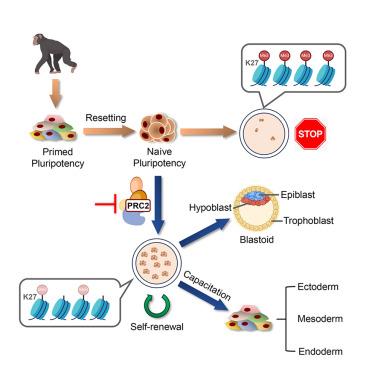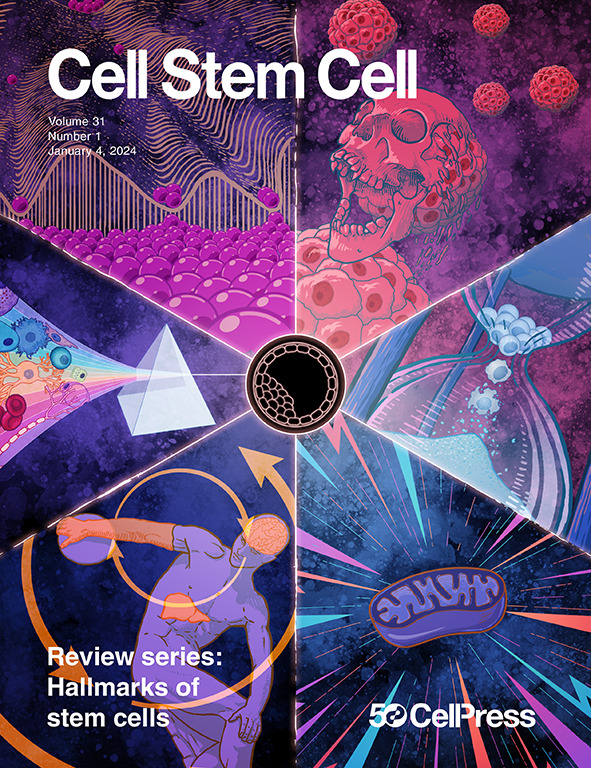Inhibition of PRC2 enables self-renewal of blastoid-competent naive pluripotent stem cells from chimpanzee
IF 19.8
1区 医学
Q1 CELL & TISSUE ENGINEERING
引用次数: 0
Abstract
Naive pluripotent stem cells (PSCs) are counterparts of early epiblast in the mammalian embryo. Mouse and human naive PSCs differ in self-renewal requirements and extraembryonic lineage potency. Here, we investigated the generation of chimpanzee naive PSCs. Colonies generated by resetting or reprogramming failed to propagate. We discovered that self-renewal is enabled by inhibition of Polycomb repressive complex 2 (PRC2). Expanded cells show global transcriptome proximity to human naive PSCs and embryo pre-implantation epiblast, with shared expression of a subset of pluripotency transcription factors. Chimpanzee naive PSCs can transition to multilineage competence or can differentiate into trophectoderm and hypoblast, forming tri-lineage blastoids. They thus provide a higher primate comparative model for studying pluripotency and early embryogenesis. Genetic deletions confirm that PRC2 mediates growth arrest. Further, inhibition of PRC2 overcomes a roadblock to feeder-free propagation of human naive PSCs. Therefore, excess deposition of chromatin modification H3K27me3 is an unexpected barrier to naive PSC self-renewal.

抑制PRC2可使黑猩猩胚状能幼稚多能干细胞自我更新
原始多能干细胞(PSCs)是哺乳动物胚胎中早期外胚层的对应物。小鼠和人类原始psc在自我更新需求和胚胎外谱系效力方面存在差异。在这里,我们研究了黑猩猩幼稚psc的产生。通过重置或重新编程产生的菌落无法繁殖。我们发现自我更新是通过抑制Polycomb suppression complex 2 (PRC2)实现的。扩增后的细胞显示出与人类原始psc和胚胎着床前外胚层的整体转录组接近,并具有一部分多能性转录因子的共同表达。黑猩猩幼稚的PSCs可以向多系能力过渡,也可以分化为滋养外胚层和下胚层,形成三系囊胚。因此,它们为研究多能性和早期胚胎发生提供了更高的灵长类动物比较模型。基因缺失证实了PRC2介导生长停滞。此外,抑制PRC2克服了人类初始PSCs无饲料繁殖的障碍。因此,染色质修饰H3K27me3的过量沉积是初始PSC自我更新的一个意想不到的障碍。
本文章由计算机程序翻译,如有差异,请以英文原文为准。
求助全文
约1分钟内获得全文
求助全文
来源期刊

Cell stem cell
生物-细胞生物学
CiteScore
37.10
自引率
2.50%
发文量
151
审稿时长
42 days
期刊介绍:
Cell Stem Cell is a comprehensive journal covering the entire spectrum of stem cell biology. It encompasses various topics, including embryonic stem cells, pluripotency, germline stem cells, tissue-specific stem cells, differentiation, epigenetics, genomics, cancer stem cells, stem cell niches, disease models, nuclear transfer technology, bioengineering, drug discovery, in vivo imaging, therapeutic applications, regenerative medicine, clinical insights, research policies, ethical considerations, and technical innovations. The journal welcomes studies from any model system providing insights into stem cell biology, with a focus on human stem cells. It publishes research reports of significant importance, along with review and analysis articles covering diverse aspects of stem cell research.
 求助内容:
求助内容: 应助结果提醒方式:
应助结果提醒方式:


